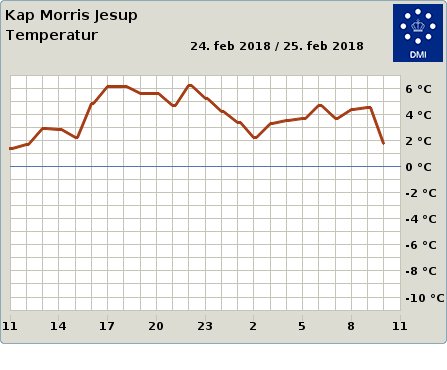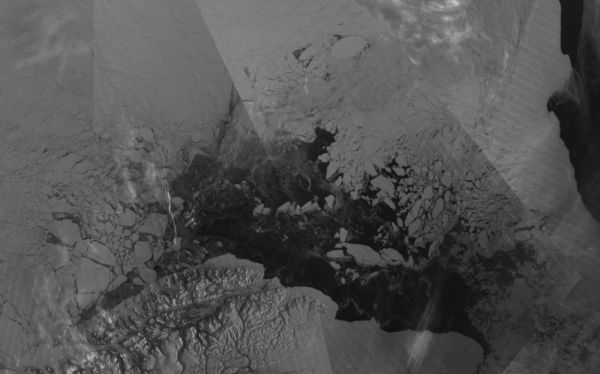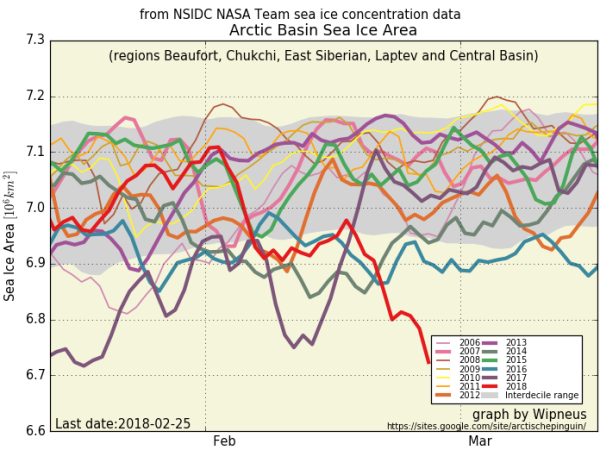A Large Area of Open Water Forms in the Melting Sea Ice North of Greenland During February
In concert with an unprecedented polar warming event, it now appears that the Atlantic side of the Arctic Ocean is seeing some severe sea ice losses.
Warm winds blowing at up to gale force intensity from the south have assaulted the ice with high waves and above-freezing temperatures for about four days now. The ice edge north of Svalbard is being rapidly beaten back. Perhaps more disturbing, is the fact that the ice pack to the north of Greenland has also now withdrawn — opening up a huge polynya.
(Massive hole in the sea ice expands north of Greenland on February 26th. Image source: NASA.)
Looking at the N. Greenland area, we find a fractured, thinning mess along a region of sea ice that should be meters thick and growing thicker at this time in February. Such a state would be remarkable during summer time, but is much more-so in what should be the dark chill of winter polar night.
To be clear, as Neven notes in his most recent Sea Ice Blog, it’s not simply wind blowing the ice around here. It’s melt due to temperatures rising between 40 and 60 F above average over a large region of the Arctic. A region that yesterday saw a 33-34 F (1-2 F above freezing) temperature at the North Pole.
Temperatures are still breaking records at North Greenland. +6 C (43 F) for a daily high is not just a record for February, it beats the highest temperature observed at this site in March or April as well.
This is roughly 35 C (63 F) above normal for this time of year.

7 antwoorden186 retweets128 vind-ik-leuks
- So, apparently DMI has a reading from Morris Jesup of +7.8 C on Feb. 12, 2011. The GSOD archive of Morris Jesup that I have been relying on only gives a high of +5.4 C on that day. Assuming the DMI reading is authoritative, then the recent +6 C is actually not a record.2 antwoorden6 retweets8 vind-ik-leuks
- An updated time series for Cape Morris Jesup, Northern Greenland using DMI's hourly values. The last 10 days have seen a series of swings near and above freezing.
 3 antwoorden19 retweets23 vind-ik-leuks
3 antwoorden19 retweets23 vind-ik-leuks - In 2018, there have already been 61 hours above freezing at Cape Morris Jesup, Greenland. The previous record was 16 hours before the end of April in 2011.
 5 antwoorden126 retweets115 vind-ik-leuks
5 antwoorden126 retweets115 vind-ik-leuks
Nieuw gesprek
Closer to the massive expanse of water opening up in the ice, Cape Morris Jesup, the furthest north point in Greenland, has now experienced 61 melting hours during winter in 2018. This is comparable to 2011, which set the previous record for winter and early spring melt at 16 hours for the Morris Jesup location. This weekend, the typically frigid point on Greenland’s north coast saw a 43 degree Fahrenheit high in the 24-hour-long darkness (no sunlight or insolation) and at a time when usual daily peak readings hit a frosty -20 F.
The underside of sea ice melts at around -2 F, due to the salt content in the water. But surface portions of the ice still need above freezing temps to result in melt and ponding. Since this region of the Arctic tends to remain near or well below freezing year-round, the present temperatures are enabling unprecedented winter damage to the ice and the environments it supports.
There is open water north of #Greenland where the thickest sea ice of the #Arctic used to be. It is not refreezing quickly because air temperatures are above zero confirmed by @dmidk's weather station #KapMorrisJesup. Wacky weather continues with scary strength and persistence.
27 antwoorden1.099 retweets1.019 vind-ik-leuks
Overall, Arctic sea ice extent is now at record low levels for this time of year. According to JAXA, hitting 13.64 million square kilometers today — or nearly 2 million square kilometers below 1980s averages.
These record daily and seasonal lows are occurring following a major loss of ice in the Bering Sea and in concert with the rapid sea ice setbacks we are presently seeing on the Atlantic side.
It is possible, given the present trend, that the Arctic will experience back-to-back years of record low seasonal ice during winter. 2016-2017 saw a crash in winter sea ice and we are presently even below the record low extents seen at that time.
(Arctic Basin sea ice is at record lows and trending lower. Image source: The Arctic Sea Ice Blog. Graph by Wipneus.)
Only a month and a half of typical freeze season remains. But ten day forecasts indicate that Arctic region mean temperatures might return closer to normal ranges (0 to 1 C above average as opposed the 3-6 C above average) and could allow for some moderate recovery of the substantially reduced winter ice pack.
Overall, though, the tale so far has been one of highly unusual melt and warming. One that highlights the serious and worsening impacts of human-caused warming and related polar amplification.
(UPDATES TO FOLLOW)

























1 opmerking:
Fascist Israel ,killing Gazan fishermen..............
https://www.haaretz.com/israel-news/israel-navy-shoots-palestinian-to-death-off-gaza-coast-1.5847893
Een reactie posten